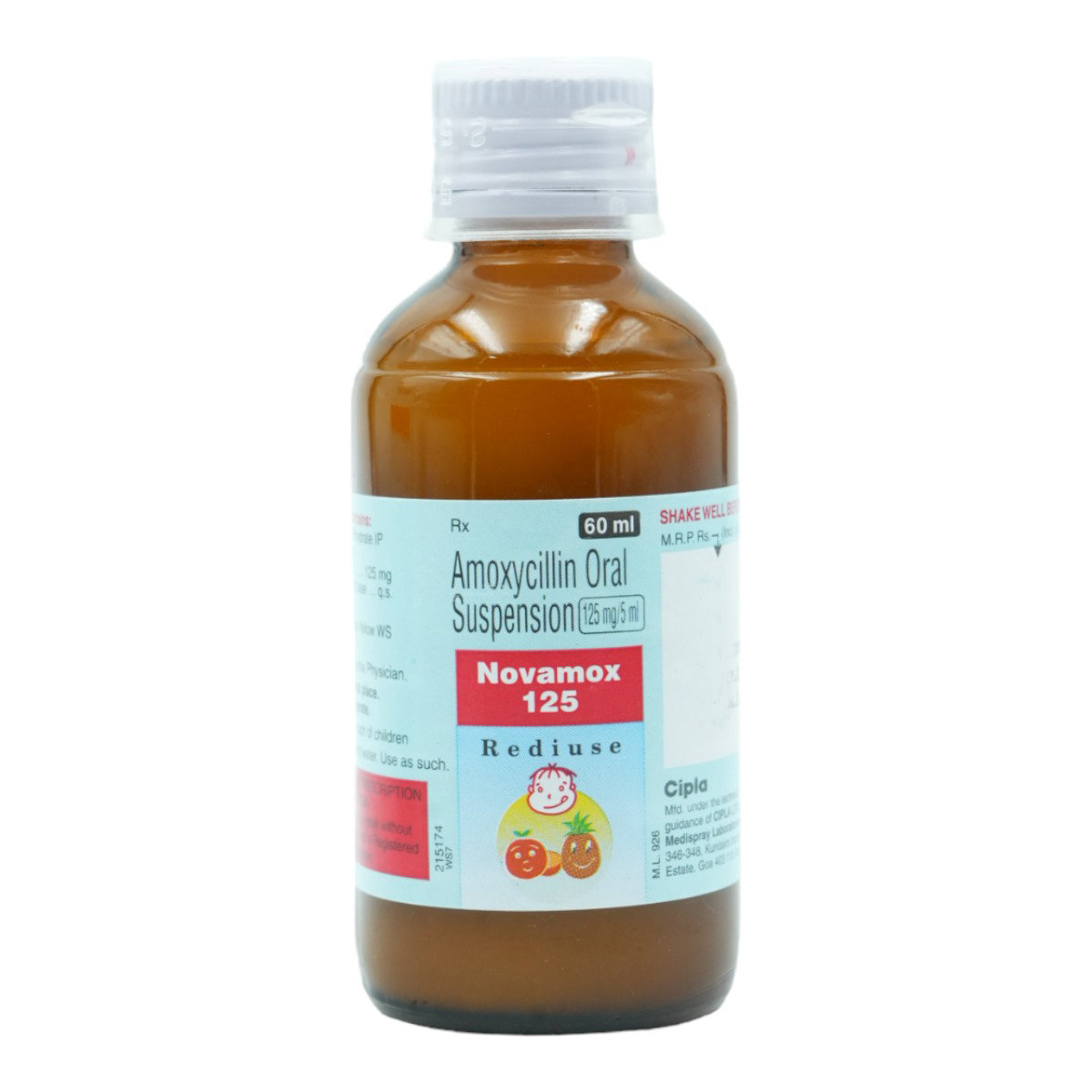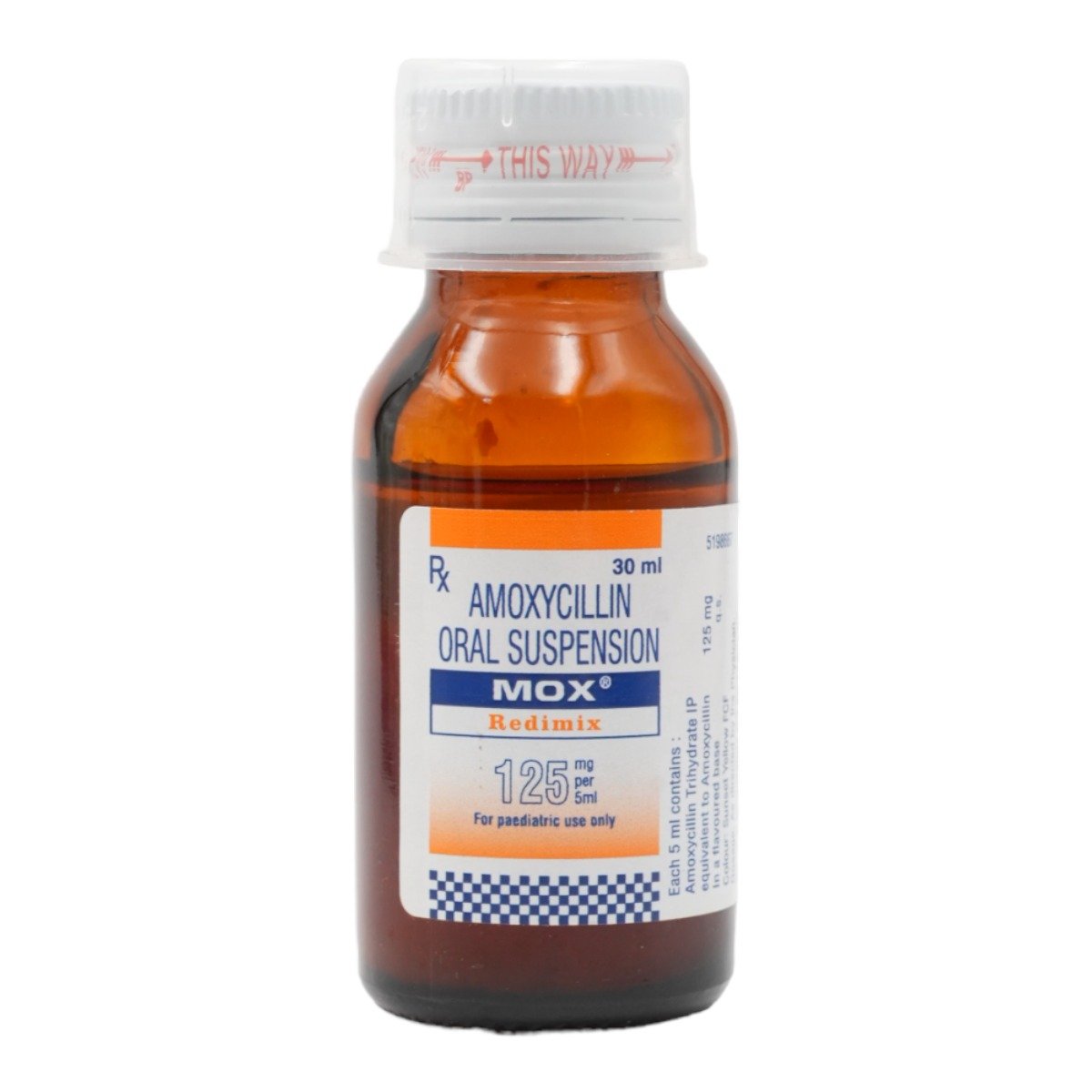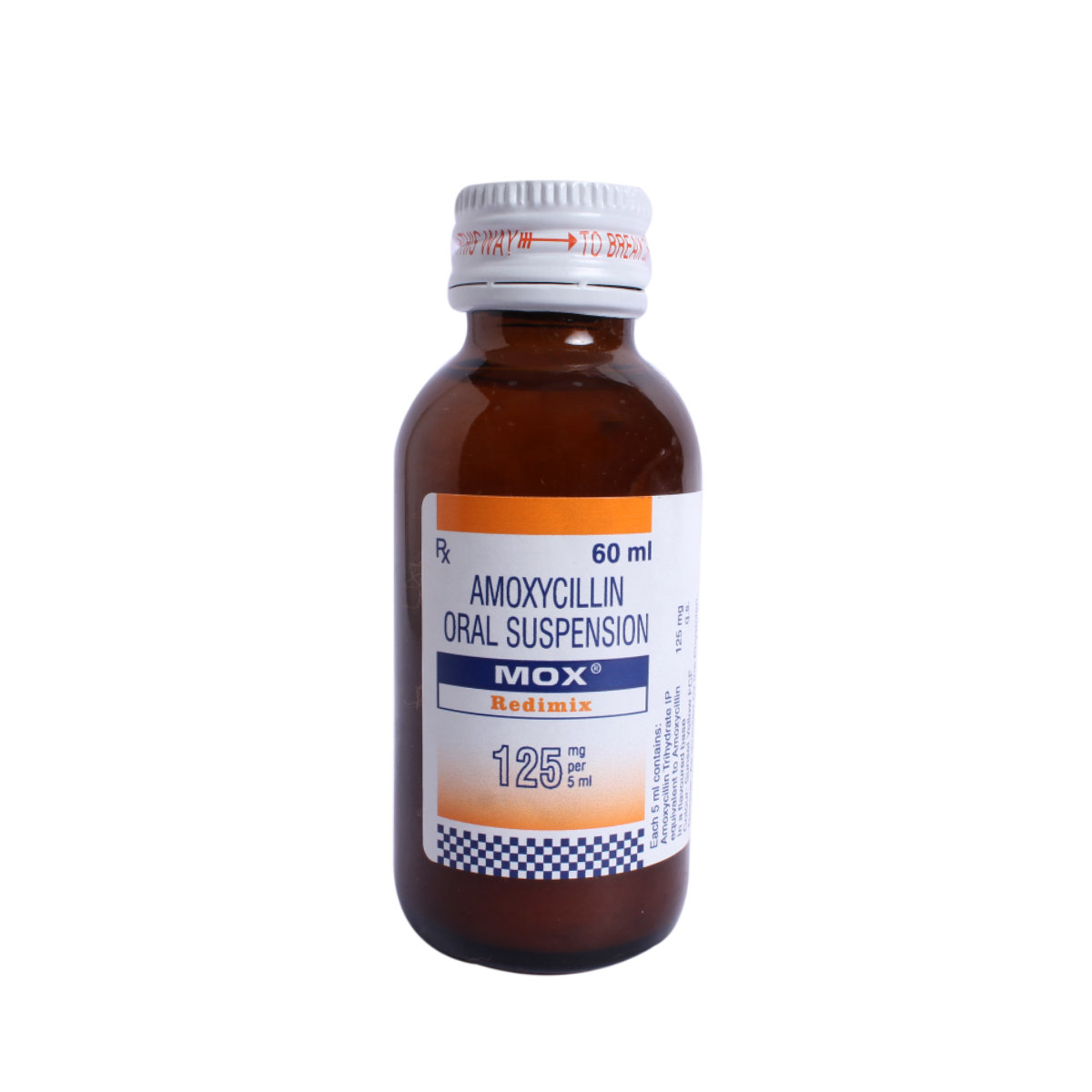Moxvid 30Ml Susp


MRP ₹19.21
(Inclusive of all Taxes)
₹2.9 Cashback (15%)
Provide Delivery Location
Online payment accepted
 Prescription drug
Prescription drugWhats That
About Moxvid 30Ml Susp
Moxvid 30Ml Susp belongs to a group of anti-bacterial or antibiotics known as penicillin. Moxvid 30Ml Susp is used to prevent and treat different types of bacterial infections like chest infections (pneumonia, bronchitis), ear/nose/throat (ENT) infections, urinary tract infections, skin infections, leg ulcers, gum ulcers, and dental infections, and pressure sores. Besides this, it is also used with various antibiotics like clarithromycin to treat stomach ulcers caused by H. Pyroli bacteria.
Moxvid 30Ml Susp has a similar method of killing bacteria as penicillin. Moxvid 30Ml Susp kills the bacterial cell by blocking the chemical (mucopeptides) released by the bacteria's outer layer (cell wall). In turn, Moxvid 30Ml Susp weakens and destroys the bacterial cell wall. It is a broad range of antibiotics that helps in fighting various types of bacteria.
Moxvid 30Ml Susp is available in oral tablets, capsules and syrup dosage forms. You should take the syrup form of Moxvid 30Ml Susp as your doctor advises. The tablet or capsule form of Moxvid 30Ml Susp should be swallowed whole with a glass of water. Do not crush, chew or break it. Most bacterial infections get treated within one week, while some conditions might take longer. So, it would be best if you tried to complete the prescribed dosage. During the treatment with Moxvid 30Ml Susp, you may observe some common side effects like feeling sick (nausea) and diarrhoea. But these side effects are usually in the initial phase and then resolve after some time. However, if these side effects persist, let your doctor know. Prolonged intake of the liquid form of Moxvid 30Ml Susp may cause temporary staining of teeth (especially in children) that can be removed by brushing.
To treat your condition effectually, continue using Moxvid 30Ml Susp for as long as your doctor has prescribed it. Do not use Moxvid 30Ml Susp without doctor's advice if you had a skin reaction or irritation to any medicine. Do not use Moxvid 30Ml Susp in more than prescribed doses or longer duration as it may cause adverse effects. Keep your doctor informed about your health condition and all the medicines you take before taking Moxvid 30Ml Susp to rule out any side effects. Do not discontinue or abruptly stop the medication as it may lead to antibiotic resistance, a condition in which bacteria become resistant to antibiotics.
Uses of Moxvid 30Ml Susp
Directions for Use
Key Benefits
Moxvid 30Ml Susp is a broad-spectrum antibiotic that helps treat various bacterial infections like ear, nose, or throat (ENT) infections, skin infections, genitourinary tract, and lower respiratory tract infections (LRTI) caused by susceptible bacteria. Moxvid 30Ml Susp is effective against gram-positive (S. pneumoniae) and gram-negative bacteria (E Coli, Haemophilus influenza, Neisseria gonorrhoea). Besides this, Moxvid 30Ml Susp also helps treat stomach ulcers caused by the H Pyroli bacteria. And if combined with antibiotics like clarithromycin and acidity, medicine like lansoprazole help reduce the symptoms of duodenum ulcer. Moxvid 30Ml Susp can be safely prescribed and well-tolerated among adults, children, pregnant and nursing mothers.
Storage
- Inform Your Doctor: Notify your doctor immediately about your diarrhoea symptoms. This allows them to adjust your medication or provide guidance on managing side effects.
- Stay Hydrated: Drink plenty of fluids to replace lost water and electrolytes. Choose water, clear broth, and electrolyte-rich drinks. Avoid carbonated or caffeinated beverages to effectively rehydrate your body.
- Follow a Bland Diet: Eat easy-to-digest foods to help firm up your stool and settle your stomach. Try incorporating bananas, rice, applesauce, toast, plain crackers, and boiled vegetables into your diet.
- Avoid Trigger Foods: Steer clear of foods that can worsen diarrhoea, such as spicy, fatty, or greasy foods, high-fibre foods, and dairy products (especially if you're lactose intolerant).
- Practice Good Hygiene: Maintain good hygiene to prevent the spread of infection. To stay healthy, wash your hands frequently, clean and disinfect surfaces regularly, and avoid exchanging personal belongings with others.
- Take Anti-Diarrheal Medications: If your doctor advises, anti-diarrheal medications such as loperamide might help manage diarrhoea symptoms. Always follow your doctor's directions.
- Keep track of your diarrhoea symptoms. If they don't get better or worse or are accompanied by severe stomach pain, blood, or dehydration signs (like extreme thirst or dark urine), seek medical help.
- Inform your doctor about the nausea and discuss possible alternatives to the medication or adjustments to the dosage.
- Divide your daily food intake into smaller, more frequent meals to reduce nausea.
- Opt for bland, easily digestible foods like crackers, toast, plain rice, bananas, and applesauce.
- Avoid certain foods that can trigger nausea, such as fatty, greasy, spicy, and smelly foods.
- Drink plenty of fluids, such as water, clear broth, or electrolyte-rich beverages like coconut water or sports drinks.
- Use ginger (tea, ale, or candies) to help relieve nausea.
- Get adequate rest and also avoid strenuous activities that can worsen nausea.
- Talk to your doctor about taking anti-nausea medication if your nausea is severe.
- Record when your nausea occurs, what triggers it, and what provides relief to help you identify patterns and manage your symptoms more effectively.
- Drink water or other clear fluids.
- To prevent worsening of pain, limit intake of tea, coffee, or alcohol.
- Include bland foods like rice, toast, crackers, and rice in your diet.
- Avoid lying down immediately after eating as it may cause indigestion or heartburn.
- Avoid acidic and spicy food as it may cause indigestion.
- Consult your doctor if you experience skin redness, itching, or irritation after taking medication.
- Your doctor may adjust your treatment plan by changing your medication or providing guidance on managing your erythema symptoms.
- Your doctor may recommend or prescribe certain medications to help alleviate symptoms.
- Apply cool compresses or calamine lotion to the affected skin area to reduce redness and itching.
- Stay hydrated by drinking plenty of water to help alleviate symptoms and keep your skin hydrated.
- Monitor your skin condition closely and promptly report any changes, worsening symptoms, or concerns to your healthcare provider.
- Skin rash caused by allergies is due to irritants or allergens. Therefore, avoid contact with such irritants.
- Consult your doctor for proper medication and apply an anti-itch medication. Follow the schedule and use the medication whenever needed.
- Protect your skin from extreme heat and try to apply wet compresses.
- Soak in the cool bath, which gives a soothing impact to the affected area.
- If you experience symptoms like itching, burning, redness, or discharge after taking medication, consult your doctor immediately and share your symptoms, medication regimen, and medical history.
- Your doctor will assess your medication regimen to determine if it's contributing to the moniliasis and identify the best course of action to manage your condition.
- Your doctor may prescribe antifungal medications or recommend other treatments to help clear up the infection. They may also suggest self-care measures to help manage symptoms and prevent future infections.
- If your condition doesn't improve or persists, consult your doctor and report it. Your doctor will assess your progress, adjust your treatment plan, and provide advice to ensure the best outcome.
Drug Warnings
Serious allergic reactions may be reported in patients taking Moxvid 30Ml Susp, including raised itchy skin rashes, wheezing, chest tightness, and coughing. Taking Moxvid 30Ml Susp may cause antibiotic-induced diarrhoea in some cases. Penicillin antibiotics, blood thinners (warfarin, coumadin), uric acid-lowering drugs (allopurinol, probenecid), and anti-cancer or anti-arthritis drugs (methotrexate) may severely interact with Moxvid 30Ml Susp. Tell your doctor if you have chronic kidney disease or viral glandular fever (mononucleosis) before taking Moxvid 30Ml Susp. This medicine may lower the efficiency of oral birth control pills or contraceptive devices. An intake of Moxvid 30Ml Susp may alter some glucose urine tests like the copper reduction test report.
Drug-Drug Interactions
Drug-Drug Interactions
Login/Sign Up
Co-administration of BCG vaccine with Moxvid 30Ml Susp may reduce the effect of BCG vaccine.
How to manage the interaction:
If you are about to receive BCG vaccine, inform the doctor that you are taking Moxvid 30Ml Susp. Do not discontinue the medication without consulting a doctor.
Co-administration of methotrexate with Moxvid 30Ml Susp can increase the levels and side effects of methotrexate.
How to manage the interaction:
Although there is a possible interaction between methotrexate and Moxvid 30Ml Susp, you can take these medicines together if prescribed by your doctor. However, if you experience any symptoms such as tiredness, dizziness, fainting, unusual bleeding or bruising, chills, fever, sore throat, body pains. Consult a doctor immediately. Do not stop using medications without a doctor's advice.
Co-administration of Moxvid 30Ml Susp with doxycycline may reduce the therapeutic effect of Moxvid 30Ml Susp.
How to manage the interaction:
Although there is a possible interaction between Moxvid 30Ml Susp and Doxycycline, you can take these medicines together if prescribed by your doctor. Do not stop using any medications without consulting a doctor.
Co-administration of Moxvid 30Ml Susp and Cholera, live attenuated may reduce the activity of the vaccine.
How to manage the interaction:
If you are currently being treated with Moxvid 30Ml Susp or have been treated within the last 14 days, talk to your doctor before receiving cholera vaccine, live. Do not discontinue the medication without consulting a doctor.
Co-administration of Moxvid 30Ml Susp and Zalcitabine can be decreased when combined with Moxvid 30Ml Susp.
How to manage the interaction:
There may be a possibility of interaction between Zalcitabine and Moxvid 30Ml Susp, but it can be taken if prescribed by a doctor. Do not discontinue any medications without consulting a doctor.
Drug-Food Interactions
Drug-Food Interactions
Login/Sign Up
Diet & Lifestyle Advise
- After taking the full course of Moxvid 30Ml Susp, probiotics should be taken to restore some of the healthy bacteria in the intestine that may have been killed. Taking probiotics after antibiotic treatment can reduce the risk of antibiotic-associated diarrhoea. Certain fermented foods like yoghurt, cheese, sauerkraut and kimchi can restore the intestine's good bacteria stink.
- Include more fibre-enriched food in your diet, as it can be easily digested by gut bacteria which helps stimulate their growth. Thus fibre foods may help restore healthy gut bacteria after taking a course of antibiotics. Whole grains like whole-grain bread, and brown rice, should be included in your diet.
- Avoid taking too many calcium-enriched foods and drinks as it might affect the working of Moxvid 30Ml Susp.
- Avoid intake of alcoholic beverages with Moxvid 30Ml Susp as it can make you dehydrated and affect your sleep. This can make it harder for your body to aid the Moxvid 30Ml Susp in fighting off infections.
Side Effects of Moxvid 30Ml Susp
- Feeling sick (nausea)
- Diarrhoea
Habit Forming
Therapeutic Class
All Substitutes & Brand Comparisons
RX
Out of StockAmurol NX 125mg Suspension
Alembic Pharmaceuticals Ltd
₹14.23
(₹0.21/ 1ml)
63% CHEAPERRX
Out of StockAmoxycillin 125mg Oral Suspension
Nestor Pharmaceuticals Ltd
₹7.5
(₹0.23/ 1ml)
60% CHEAPERRX
Out of StockZymox Premix 125mg Oral Suspension
₹18.3
(₹0.55/ 1ml)
5% CHEAPER
Product Substitutes
Author Details
We provide you with authentic, trustworthy and relevant information
Drug-Diseases Interactions
Drug-Diseases Interactions
Login/Sign Up
Nearly all antibacterial medications have been associated with Clostridioides difficile-associated diarrhoea (CDAD), formerly known as pseudomembranous colitis, which can range in severity from mild diarrhoea to deadly colitis. Lincomycin and clindamycin are typically to blame. Antibacterial treatment disrupts the colon's normal flora, promoting the growth of C. difficile, whose toxins A and B contribute to the emergence of CDAD.
How to manage the interaction:
Moxvid 30Ml Susp should be used with caution in patients with a history of gastrointestinal disease, particularly colitis (inflammation in the large intestine) and pseudomembranous colitis (generally characterized by severe, persistent diarrhoea and severe abdominal cramps and sometimes associated with the passage of blood and mucus).
When given an aminopenicillin antibiotic for mononucleosis, patients may experience a pruritic, erythematous, maculopapular skin rash. Usually, the rash self-limits and goes away a few days after the offending chemical is stopped. The underlying mechanism has been suggested to be a changed drug metabolism or an immune-mediated process unrelated to drug hypersensitivity. Patients with mononucleosis shouldn't receive treatment with antibiotics containing aminopenicillin.
How to manage the interaction:
Moxvid 30Ml Susp should not be used in patients with mononucleosis (contagious infection caused by virus) as it may cause skin rash.
When utilising Clinitest®, Benedict's Solution, or Fehling's Solution to test for the presence of glucose in urine, high ampicillin concentrations in the urine may provide false-positive results. It is advised to use glucose tests based on enzymatic glucose oxidase reactions,as this effect may also occur with Moxvid 30Ml Susp.
How to manage the interaction:
High urine concentrations of Moxvid 30Ml Susp may result in false-positive reactions when testing for the presence of glucose in urine using Benedict's Solution or Fehling's Solution. Hence, it is recommended to use glucose tests based on enzymatic glucose oxidase reactions.
The kidneys remove the majority of beta-lactam antibiotics as unaltered drugs and, in some situations, as metabolites as well. In patients with poor renal function, the blood concentrations of beta-lactam antibiotics and their metabolites may rise, and their half-lives may be prolonged. According to the individual product package labelling, dosage modifications may be required. These alterations should be based on the severity of the infection as well as the degree of renal impairment. Renal function tests should be carried out on a regular basis during prolonged and/or high-dose therapy because these medicines have occasionally been linked to nephrotoxicity and changes in renal function.
How to manage the interaction:
Dose adjustments may be required in patients with kidney impairment. Kidney function tests should be performed at regular intervals during prolonged and/or high-dose therapy since nephrotoxicity (rapid deterioration in kidney function) and alterations in kidney function have occasionally been associated with the use of Moxvid 30Ml Susp.
FAQs
Moxvid 30Ml Susp kills the bacterial cell by blocking the chemical (mucopeptides) released by the bacteria's outer layer (cell wall). In turn, Moxvid 30Ml Susp weakens and destroys the bacterial cell wall. It is a broad range of antibiotics that helps in fighting various types of bacteria.
No, Moxvid 30Ml Susp may help to a certain extent but is not prescribed to treat bacterial vaginitis. However, it is better to consult a doctor for its treatment. In most cases, Metronidazole is the most effective treatment for anaerobic bacteria which cause vaginal infection.
Moxvid 30Ml Susp belongs to the class of penicillin antibiotic. Moxvid 30Ml Susp is a broad-spectrum antibiotic effective against a wide range of bacteria. On the other hand, penicillin is a narrow-spectrum antibiotic effective against fewer bacteria.
Do not use anti diarrhoeal until the doctor has prescribed you. You can drink plenty of fluids (electrolytes) to avoid dehydration. Besides this, you can also take prebiotics or probiotics to manage diarrhoea as it may help increase the number of good bacteria in the intestine, which aids indigestion.
Try to stay well hydrated by drinking at least six glasses of water or other fluid per day. Always keep your bladder empty as much as possible by peeing regularly.
Clinical evidence suggests that Moxvid 30Ml Susp is safe for pregnant mothers. However, you should consult a doctor before taking Moxvid 30Ml Susp.
After taking an antibiotic, you may need to wait for up to three hours to eat or drink any dairy products, including milk and butter, yoghurt, and cheese. Grapefruit juice and dietary supplements containing minerals like calcium may also work to dampen the effect of antibiotics.
Do not stop using Moxvid 30Ml Susp even if you feel better. It should be strictly used as advised by your doctor to avoid the recurrence of symptoms and to worsen the disease.
Drug-Drug Interactions Checker List
- WARFARIN
- COUMADIN
- ALLOPURINOL
- PROBENECID
- METHOTREXATE
Disease/Condition Glossary
Bacterial infections: A bacterial infection is a condition in which harmful bacteria enter, multiply, and infect our body. It can target any body part and multiple very quickly. When you get infected with bacteria, you can experience generalized symptoms like fevers, chills, and fatigue. Bacteria are of various forms comprising commonly spherical, rod, and spiral-shaped. Bacterial infections vary from minor illnesses like sore throat and ear infections to severe brain infections like meningitis and encephalitis. Few harmful bacteria that cause infections include Streptococcus, Staphylococcus, and E. coli. Anyone can become infected with a bacterial infection. But, people with weak immune systems or taking immunosuppressive medicine can make you more prone to bacterial infection.

Have a query?
Buy best Infections & Infestation products by
Cipla Ltd
Macleods Pharmaceuticals Ltd
Alkem Laboratories Ltd
Lupin Ltd
Abbott India Ltd
Sun Pharmaceutical Industries Ltd
Mankind Pharma Pvt Ltd
Micro Labs Ltd
Aristo Pharmaceuticals Pvt Ltd
FDC Ltd
Intas Pharmaceuticals Ltd
Glenmark Pharmaceuticals Ltd
Ipca Laboratories Ltd
Torrent Pharmaceuticals Ltd
Zydus Healthcare Ltd
Biochem Pharmaceutical Industries Ltd
Zuventus Healthcare Ltd
United Biotech Pvt Ltd
Hetero Drugs Ltd
Emcure Pharmaceuticals Ltd
Alembic Pharmaceuticals Ltd
Indoco Remedies Ltd
Fusion Health Care Pvt Ltd
Dr Reddy's Laboratories Ltd
Leeford Healthcare Ltd
Cadila Healthcare Ltd
Wockhardt Ltd
Zydus Cadila
GlaxoSmithKline Pharmaceuticals Ltd
Morepen Laboratories Ltd
Blue Cross Laboratories Pvt Ltd
Cadila Pharmaceuticals Ltd
Converge Biotech Pvt Ltd
Elder Pharmaceuticals Ltd
Hetero Healthcare Pvt Ltd
Pfizer Ltd
AAA Pharma Trade Pvt Ltd
Gufic Bioscience Ltd
Mylan Pharmaceuticals Pvt Ltd
Corona Remedies Pvt Ltd
Wallace Pharmaceuticals Pvt Ltd
Apex Laboratories Pvt Ltd
Medishri Healthcare Pvt Ltd
Akumentis Healthcare Ltd
Alniche Life Sciences Pvt Ltd
Hegde & Hegde Pharmaceutica Llp
Veritaz Healthcare Ltd
Ranbaxy Laboratories Ltd
Koye Pharmaceuticals Pvt Ltd
Shreya Life Sciences Pvt Ltd
Overseas Health Care Pvt Ltd
Biocon Ltd
Indchemie Health Specialities Pvt Ltd
Medley Pharmaceuticals Ltd
Brinton Pharmaceuticals Ltd
J B Chemicals & Pharmaceuticals Ltd
Unifaith Biotech Pvt Ltd
Ajanta Pharma Ltd
Biochemix Health Care Pvt Ltd
Natco Pharma Ltd
Samarth Life Sciences Pvt Ltd
Unichem International
Laborate Pharmaceuticals India Ltd
Unipark Biotech Pvt Ltd
Zymes Bioscience Pvt Ltd
Indiabulls Pharmaceuticals Pvt Ltd
Neon Laboratories Ltd
Vasu Organics Pvt Ltd
DR Johns Lab Pharma Pvt Ltd
East West Pharma India Pvt Ltd
La Renon Healthcare Pvt Ltd
Medgen Drugs And Laboratories Pvt Ltd
Novartis India Ltd
Canixa Life Sciences Pvt Ltd
Icarus Health Care Pvt Ltd
Lincoln Pharmaceuticals Ltd
Celon Laboratories Pvt Ltd
Concept Pharmaceuticals Ltd
Klm Laboratories Pvt Ltd
Nicholas Piramal India Ltd
Systopic Laboratories Pvt Ltd
Yuventis Pharmaceuticals
Capital Pharma
German Remedies Ltd
Pristine Pearl Pharma Pvt Ltd
Unison Pharmaceuticals Pvt Ltd
Aurz Pharmaceutical Pvt Ltd
Clover Health Care Pharma
Kepler Healthcare Pvt Ltd
Allites Life Sciences Pvt Ltd
Auspharma Pvt Ltd
Intra Life Pvt Ltd
Jolly Healthcare
Linux Laboratories Pvt Ltd
Ozone Pharmaceuticals Ltd
Cachet Pharmaceuticals Pvt Ltd
Comed Chemicals Ltd
Delcure Life Sciences Ltd
Fresenius Kabi India Pvt Ltd
Khandelwal Laboratories Pvt Ltd
Alcohol
Safe if prescribed
Do not drink too much while taking this medicine. Drinking a lot of alcohol may more likely to drowsiness, dizziness or sleepiness side effects.
Pregnancy
Consult your doctor
Moxvid 30Ml Susp is a pregnancy category B drug. So, Moxvid 30Ml Susp can be safely taken by pregnant women if prescribed by the doctor.
Breast Feeding
Consult your doctor
Can safely give Moxvid 30Ml Susp to breastfeeding mothers.
Driving
Safe if prescribed
You may have side effects like dizziness after taking Moxvid 30Ml Susp that may make you unfit to drive. So, it is advisable not to drive or operate machinery until you are feeling well.
Liver
Consult your doctor
Moxvid 30Ml Susp can be safely taken in case of liver disease if prescribed by the doctor. Your doctor will weigh the benefits and any potential risks before prescribing Moxvid 30Ml Susp.
Kidney
Consult your doctor
Take Moxvid 30Ml Susp with caution if you have severe kidney disease. Your doctor may reduce the dose of Moxvid 30Ml Susp in patients with severe renal impairment (GFR less than 30 mL/min).
Children
Safe if prescribed
Can be Moxvid 30Ml Susp safely to children, dose to be adjusted and recommended by a child specialist only.









